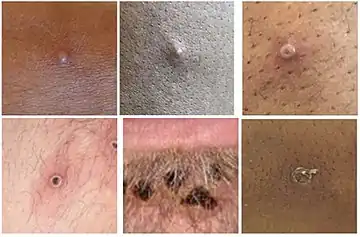2022–2023 mpox outbreak in France
| 2022 – 2023 mpox outbreak in France | |
|---|---|
| Disease | Mpox |
| Virus strain | Monkeypox virus (West African clade) |
| Location | France |
| Index case | Paris, France |
| Arrival date | 20 May 2022 (1 year, 6 months and 2 days ago) |
| Date | As of 5 October 2022[1] |
| Confirmed cases | 4,043[1] |
The 2022 – 2023 mpox outbreak in France is part of the larger outbreak of human mpox caused by the West African clade of the monkeypox virus. France had its first case on 20 May 2022.
Background
Mpox (formerly known as monkeypox)[2] is an infectious viral disease that can occur in humans and some other animals.[3] Symptoms include a rash that forms blisters and then crusts over, fever, and swollen lymph nodes.[3] The illness is usually mild and most of those infected will recover within a few weeks without treatment.[4] The time from exposure to onset of symptoms ranges from five to twenty-one days and symptoms typically last from two to four weeks.[5] Cases may be severe, especially in children, pregnant women or people with suppressed immune systems.[6]
The disease is caused by the monkeypox virus,[lower-alpha 1] a zoonotic virus in the genus Orthopoxvirus. The variola virus, the causative agent of the disease smallpox, is also in this genus.[3] Human-to-human transmission can occur through direct contact with infected skin or body fluids, including sexual contact.[3] People remain infectious from the onset of symptoms until all the lesions have scabbed and healed.[6] It may spread from infected animals by handling infected meat or via bites or scratches.[6] Diagnosis can be confirmed by PCR testing a lesion for the virus' DNA.[3]- Detection in Europe
Transmission

A large portion of those infected were believed to have not recently traveled to areas of Africa where mpox is normally found, such as Nigeria, the Democratic Republic of the Congo as well as central and western Africa. It is believed to be transmitted by close contact with sick people, with extra caution for those individuals with lesions on their skin or genitals, along with their bedding and clothing. The CDC has also stated that individuals should avoid contact and consumption of dead animals such as rats, squirrels, monkeys and apes along with wild game or lotions derived from animals in Africa.[10]
Cases
As of 2 August 2022, there were 2,171 confirmed cases of mpox reported in France,[11] and as of 29 August 2022, there were 3,547 confirmed cases reported.[12] As of 4 October 2022 there were 4,043 cases.[1]
Ref:
- FRA: June 7th, 9th, 14th, 16th, 21st,23rd, 28th July 5th, 7th, 12th, 19th, 21st, 26th, 28th,August 2nd, 4th, 9th, 11th, 16th, 18th, 23rd, 29th, Sept. 1st, 6th, 12th,[13] 20th, 22nd,27th, Oct. 4th[1]
- GER: 2022–2023 mpox outbreak in Germany#Cumulative number of cases, rev. 8 Oct. 2022
- U.S.: 2022–2023 mpox outbreak in the United States#Timeline, rev. 8 Oct. 2022
See also
Notes
- ↑ The World Health Organization (the authority on disease names) announced the new name "mpox" in November 2022. But virus naming is the responsibility of the International Committee on the Taxonomy of Viruses (ICTV), which is currently reviewing all orthopoxvirus species. As of March 2023, the official name of the virus remains "monkeypox virus".[2]
External links
- Our World in Data - Monkeypox (ourworldindata.org)
- Santé publique France: Les actualités (www.santepubliquefrance.fr)
References
- 1 2 3 4 "Cas de variole du singe : point de situation au 4 octobre 2022". www.santepubliquefrance.fr (in French). 5 October 2022. Retrieved 8 October 2022.
- 1 2 "WHO recommends new name for monkeypox disease" (Press release). World Health Organization (WHO). 28 November 2022. Retrieved 29 November 2022.
- 1 2 3 4 5 "WHO Factsheet – Mpox (Monkeypox)". World Health Organization (WHO). 18 April 2023. Archived from the original on 21 April 2022. Retrieved 21 May 2023.
- ↑ "Monkeypox". GOV.UK. 24 May 2022. Archived from the original on 18 May 2022. Retrieved 28 May 2022.
- ↑ "Mpox Symptoms". U.S. Centers for Disease Control and Prevention (CDC). 2 February 2023. Archived from the original on 21 May 2023. Retrieved 21 May 2023.
- 1 2 3 "Mpox (monkeypox)". World Health Organisation. 12 May 2023. Archived from the original on 23 May 2023. Retrieved 24 May 2023.
- ↑ "Monkeypox – United Kingdom of Great Britain and Northern Ireland". World Health Organization. 16 May 2022. Archived from the original on 17 May 2022. Retrieved 17 May 2022.
- ↑ Pinkstone, Joe (17 May 2022). "Monkeypox 'spreading in sexual networks'". The Telegraph. Archived from the original on 17 May 2022. Retrieved 17 May 2022.
- ↑ Nsofor, Ifeanyi (2 June 2022). "Opinion: Media coverage of monkeypox paints it as an African virus. That makes me mad". NPR. Retrieved 2 June 2022.
- ↑ Vargas, Ramon Antonio (7 June 2022). "US raises monkeypox alert level but says risk to public remains low". the Guardian. Retrieved 9 June 2022.
- ↑ "2,171 people infected with monkeypox in France - minister". Reuters. 2 August 2022. Retrieved 2 August 2022.
- ↑ "Cas de variole du singe : point de situation au 29 août 2022" [Monkeypox cases: update as of August 29, 2022]. www.santepubliquefrance.fr (in French). 30 August 2022. Retrieved 2 September 2022.
- ↑ Cas de variole du singe : point de situation au 12 septembre 2022